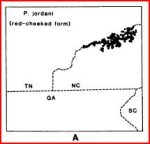Wildebeestking
New member
- Joined
- Jul 30, 2012
- Messages
- 132
- Reaction score
- 0
- Points
- 0
- Country
- United States
- Display Name
- Yaxley
Sure. Here is a better map which is more up to date.
AmphibiaWeb - Plethodon jordani
I am not sure what that isolate in Georgia is all about. I have doubts that is really P. jordani. You can also look at other species which were considered to be jordani in the past, such as shermani or cheoah. There is also the Highton and Peabody 2000 paper published in The biology of Plethodontid Salamanders. This book is full of a number of manuscripts and is super expensive. It is also very hard to get those manuscripts outside of that book. I could also recommend some articles on the evolution and relationships of Plethodon, but they do not really address geographic distribution.
Also, while Berkleymapper apparently did get an upgrade recently, which is kind of cool, their collection is not always up to date with the taxonomy. For instance, this next map is the map for Eurycea multiplicata. This species is only found in the Ouachita mountains, however in this map, it has the species ranging into the Ozarks also. However, the species in the Ozarks are actually E. tynerensis. This is described in Bonett and Chippindale 2004. "Speciation, phylogeography and evolution of life history and morphology in plethodontid salamanders of the Eurycea multiplicata complex" Interesting enough, even if they did update the map to what I just said, in a few more years, species in the Ozarks and Ouachitas are going to be split more based on genetics. This work will come out of the lab I work in, Dr. Ron Bonett.
I don't mean to pick a fight with anyone, but if those are P. jordani, then they were collected from within the park. I am not going to report anyone or anything, I am just saying. I am very familiar with Plethodontid salamanders in that area of the country. Especially, Desmogs, which often share similar distributions with Plethodon. For example, Desmognathus imitator also is primarily with the park, except for one place I know of where they do not look like imitators and it is on private property. Taherman also probably knows that place well since I am pretty sure he has collected from the park himself. Also interesting, is the specimens he collected may represent distinct species. He should really publish his thesis.
Now if you want me to comment on Plethodontid breeding, I will.
Does anyone ever have any issues with little white mites crawling on their Plethodontid eggs?
Mike
Fascinating, There's so many different types of plethodontids. Too bad they aren't very common in captivity.

